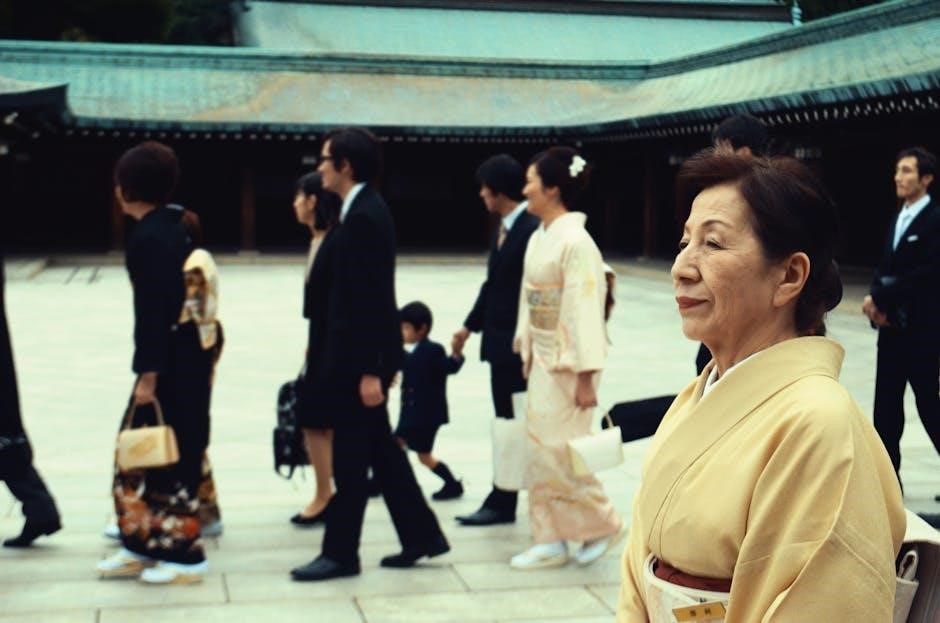The “Instructions to All Persons of Japanese Ancestry” were issued by the Western Defense Command on May 5, 1942, during World War II. This document, signed by Lieutenant General J.L. DeWitt, outlined the procedures for the forced relocation of Japanese Americans, citing national security concerns. It marked the beginning of a series of events that would profoundly impact the lives of thousands of Japanese Americans, leading to their internment in designated camps. The instructions were part of a broader effort under Executive Order 9066, which authorized the exclusion of individuals of Japanese ancestry from designated military zones. This historical document serves as a critical reminder of the tensions and policies of the time, highlighting the balance between national security and individual rights during wartime.
1.1 Historical Context of the Instructions
The “Instructions to All Persons of Japanese Ancestry” emerged amid the tumult of World War II, following the attack on Pearl Harbor in December 1941. This event heightened fears of sabotage and espionage, leading to increased suspicion of Japanese Americans. On February 19, 1942, President Franklin D. Roosevelt signed Executive Order 9066, authorizing the Secretary of War to designate military zones from which individuals of Japanese ancestry could be excluded. The Western Defense Command, under Lieutenant General J.L. DeWitt, subsequently issued these instructions, marking a turning point in the forced relocation of over 120,000 Japanese Americans. This period remains a significant chapter in U.S. history, reflecting wartime paranoia and its consequences.
1.2 Purpose of the Document
The primary purpose of the “Instructions to All Persons of Japanese Ancestry” was to facilitate the forced relocation of Japanese Americans from designated military zones to assembly centers. Issued by the Western Defense Command, the document outlined specific directives for individuals of Japanese ancestry, regardless of citizenship, to report to Civil Control Stations. It aimed to ensure compliance with Executive Order 9066, which authorized the exclusion of Japanese Americans for national security reasons. The instructions provided timelines, procedures, and details on what belongings to bring, effectively governing the logistics of their relocation and internment during World War II.

Background of the Instructions
The “Instructions to All Persons of Japanese Ancestry” emerged from Executive Order 9066, issued during World War II, authorizing the removal of Japanese Americans from military zones. The Western Defense Command oversaw the process, establishing designated areas and procedures for relocation. These instructions were part of broader wartime measures aimed at national security, reflecting the tense political climate and racial suspicions of the time.
2;1 Executive Order 9066 and Its Significance
Executive Order 9066, signed by President Franklin D. Roosevelt on February 19, 1942, authorized the Secretary of War to designate military zones from which Japanese Americans could be excluded. This order, issued following the attack on Pearl Harbor, led to the forced relocation and incarceration of over 120,000 Japanese Americans, most of whom were U.S. citizens. The order was justified as a wartime security measure but is widely regarded as a violation of civil liberties. Its significance lies in its role as the legal basis for the internment program and its enduring legacy as a symbol of wartime hysteria and racial discrimination.
2.2 The Role of the Western Defense Command
The Western Defense Command, under Lieutenant General J.L. DeWitt, played a central role in executing Executive Order 9066. It issued the “Instructions to All Persons of Japanese Ancestry,” outlining the evacuation process and establishing Civil Control Stations to manage the relocation. The command oversaw the forced removal of Japanese Americans from designated military zones, ensuring compliance with the order. Their actions led to the internment of over 120,000 individuals, primarily from the West Coast, marking a significant chapter in the history of wartime America. The Western Defense Command’s directives were pivotal in implementing the federal government’s internment policy during World War II.
2.3 Establishment of Military Areas
The Western Defense Command established Military Areas No. 1 and No. 2 under Public Proclamations of March 2 and March 16, 1942. These areas encompassed parts of California, Oregon, Washington, and Arizona, designating regions from which Japanese Americans were to be excluded. The creation of these zones was justified as a national security measure, aiming to protect the West Coast from potential espionage and sabotage. The establishment of these military areas set the legal groundwork for the subsequent evacuation orders, directly impacting thousands of Japanese Americans who were forced to leave their homes and relocate to internment camps.

Legal Framework
Executive Order 9066 and Civilian Exclusion Orders provided the legal basis for the forced relocation of Japanese Americans, authorizing military zones and exclusions for national security.
3.1 The Provisions of Public Proclamations
Public Proclamations issued on March 2 and March 16, 1942, established Military Areas No. 1 and No. 2, encompassing parts of Washington, Oregon, California, and Arizona. These proclamations authorized the exclusion of individuals of Japanese ancestry from designated zones, citing national security concerns. The proclamations outlined specific areas where Japanese Americans were prohibited from residing and mandated their relocation under military supervision. They also empowered the Western Defense Command to enforce these measures, leading to the issuance of Civilian Exclusion Orders. These proclamations effectively laid the legal groundwork for the forced removal and internment of Japanese Americans during World War II.
3.2 Civilian Exclusion Orders
Civilian Exclusion Orders were official directives issued by military authorities, such as General J.L. DeWitt, to notify individuals of Japanese ancestry about their forced relocation. These orders were publicly posted and outlined specific instructions, including the requirement to report to Civil Control Stations and the items to bring. The orders were a direct result of Executive Order 9066 and legally enforced the exclusion from designated military zones. They played a crucial role in the systematic removal of Japanese Americans during World War II, significantly impacting their lives and communities.

Instructions for Evacuation
The instructions outlined the evacuation process, requiring individuals to report to Civil Control Stations with essential items, ensuring orderly relocation under military supervision.
4.1 Key Directives for Persons of Japanese Ancestry
All persons of Japanese ancestry were required to report to designated Civil Control Stations, bringing essential items like bedding, clothing, and personal effects. They were instructed to settle affairs and prepare for relocation within a specified timeframe. The directives prohibited entering or leaving designated areas without permission, with strict penalties for non-compliance. Individuals were directed to assemble at assigned locations, where they would receive further instructions for transportation to temporary centers. The orders emphasized orderly evacuation, ensuring adherence to military directives for national security purposes during World War II.
4.2 Required Items to Bring
Persons of Japanese ancestry were instructed to bring essential items, including bedding and linens for each family member, toilet articles, extra clothing, and personal effects. Mattresses were not provided, so bedding had to be self-sufficient. Families were advised to pack lightly but practically, ensuring they had enough supplies for an undetermined period. The items were to be carried to the Civil Control Station, where they would be transported to temporary centers. These directives aimed to ensure evacuees had basic necessities while complying with the relocation orders during World War II.
4.3 Role of Civil Control Stations
Civil Control Stations played a pivotal role in the evacuation process, serving as central hubs for Japanese Americans reporting for relocation. These stations provided instructions, assistance with property management, and facilitated the transition to temporary living centers. They offered services such as storage, sale, or lease of property, including real estate, vehicles, and household goods. Additionally, the stations helped families arrange temporary housing and transportation to their new destinations. Evacuees were required to report to these stations with their essential belongings, where they received further directives and support during the relocation process under Executive Order 9066.

The Evacuation Process
The evacuation process involved systematic relocation of Japanese Americans, beginning with preparation and reporting to designated Civil Control Stations, followed by transportation to assembly centers.
5.1 Preparation and Reporting
The instructions required individuals of Japanese ancestry to prepare for evacuation by settling their personal affairs within a short timeframe. They were directed to report to designated Civil Control Stations, where they would receive further instructions. Essential items such as bedding, clothing, and personal effects were to be brought, though mattresses were not allowed. The Civil Control Stations provided assistance with property management and temporary housing arrangements. Failure to comply with the directives would result in criminal penalties. This phase marked the beginning of a structured, yet traumatic, process for thousands of Japanese Americans.
5.2 Transportation to Assembly Centers
After reporting to Civil Control Stations, individuals of Japanese ancestry were transported to assembly centers. These centers served as temporary holding facilities before relocation to more permanent camps. The process was organized by the Western Defense Command, with transportation typically provided by military or civilian authorities. Once at the centers, families were housed in barracks or other communal facilities, often under cramped and basic conditions. The transition marked the start of a prolonged period of uncertainty and hardship for Japanese Americans, as they were forced to leave behind their homes and livelihoods with limited possessions.

Challenges Faced by Japanese Americans
Japanese Americans endured emotional distress, financial loss, and social stigma due to forced relocation and internment, disrupting lives and communities indefinitely.
6.1 Emotional and Financial Hardships
The forced relocation caused immense emotional trauma, as families were uprooted from their homes and communities. Many experienced financial ruin, losing businesses, homes, and livelihoods. The sudden nature of the evacuation left little time to secure property or assets, exacerbating economic hardship. Emotional distress was compounded by the uncertainty of their future and the harsh conditions in internment camps. Families were often separated, and the loss of dignity and freedom deeply affected morale. These hardships lingered long after the war, impacting generations and leaving lasting scars on Japanese American communities.
6.2 Legal and Social Implications
The forced relocation of Japanese Americans raised significant legal and social concerns. Executive Order 9066 bypassed judicial oversight, violating constitutional rights and setting a precedent for racial discrimination. The internment highlighted the fragility of civil liberties during wartime, as Japanese Americans were deprived of due process and equal protection under the law. Socially, the internment deepened racial tensions and mistrust, perpetuating anti-Japanese sentiment. The government’s actions were later widely criticized as unjust, leading to formal apologies and reparations in 1988. This dark chapter in U.S. history underscores the importance of protecting individual rights against mass hysteria and prejudice.
Legacy of the Instructions
The “Instructions to All Persons of Japanese Ancestry” left a lasting impact, prompting formal apologies and reparations. The U.S. government acknowledged the injustice, providing compensation and sparking dialogue on racial equality and civil liberties. This dark chapter in history serves as a reminder of the dangers of mass hysteria and discrimination, while also highlighting the resilience of Japanese American communities. Educational initiatives and memorials continue to honor their experiences, ensuring such injustices are never repeated.
7.1 Impact on Japanese American Communities
The “Instructions to All Persons of Japanese Ancestry” caused profound disruption to Japanese American communities. Families were forcibly separated, businesses were abandoned, and personal property was lost. The emotional trauma of relocation and internment lingered for generations, affecting cultural identity and community cohesion. Many individuals faced financial ruin, as they were unable to recover their pre-war economic standing. Despite these hardships, the community demonstrated remarkable resilience, rebuilding lives and advocating for justice. The legacy of this period serves as a testament to the strength and perseverance of Japanese Americans in the face of systemic injustice and societal prejudice.
7.2 Modern Recognition and Apologies
In the decades following World War II, the U.S. government acknowledged the injustice of the forced relocation of Japanese Americans. The Civil Liberties Act of 1988 provided reparations and formal apologies to surviving internees, recognizing the unconstitutional nature of their treatment. Museums and memorials, such as those in the Smithsonian collection, now preserve the history of this period. Public awareness campaigns and educational programs ensure that the lessons of this dark chapter are not forgotten, promoting tolerance and preventing similar injustices. These efforts reflect a national commitment to accountability and reconciliation, honoring the resilience of Japanese American communities.
The “Instructions to All Persons of Japanese Ancestry” marked a regrettable chapter in U.S. history, leading to the internment of Japanese Americans during World War II. Modern apologies and reparations, such as the Civil Liberties Act of 1988, acknowledge the injustice and ensure such injustices are not repeated, promoting a more equitable future for all.
8.1 Summary of Key Points
The “Instructions to All Persons of Japanese Ancestry” were a series of directives issued during World War II, stemming from Executive Order 9066. These instructions mandated the relocation of Japanese Americans from designated military zones to internment camps. The process involved Civilian Exclusion Orders, Civil Control Stations, and strict guidelines on what individuals could bring. The directives caused significant emotional and financial hardship, disrupting lives and communities. The legacy of these instructions highlights the tension between national security concerns and individual rights, serving as a cautionary tale in American history about the dangers of mass incarceration based on ancestry.
8.2 Reflection on Historical Significance
The “Instructions to All Persons of Japanese Ancestry” remain a poignant reminder of the consequences of fear and prejudice during wartime. The forced relocation of Japanese Americans underscores the fragility of civil liberties in the face of national security concerns. Today, this chapter is widely regarded as a grave injustice, with formal apologies and reparations acknowledging the harm inflicted. It serves as a critical lesson in balancing security with constitutional rights, emphasizing the importance of safeguarding individual freedoms even in times of crisis. The legacy of these instructions continues to inform discussions on equity, justice, and the treatment of minority communities.
